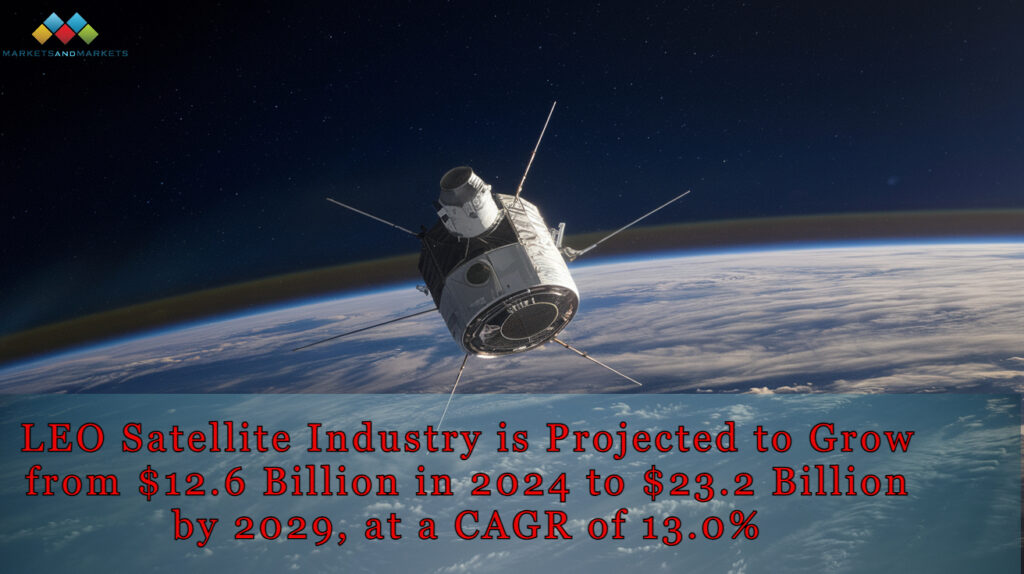LEO (Low Earth Orbit) satellites, orbiting at altitudes between 180 and 2,000 kilometers, provide significant advantages such as reduced latency and higher data transfer speeds compared to geostationary satellites. These satellites are essential for a wide range of applications, including communication, earth observation, remote sensing, and scientific research. Their proximity to Earth enables quicker signal transmission and enhanced global coverage, making them particularly valuable in high-demand sectors. Recent advancements in satellite miniaturization, mass production, and reusable launch technologies have further increased accessibility and cost-efficiency, driving rapid growth and innovation in the LEO satellite market.
The LEO (Low Earth Orbit) satellite market is expected to grow from USD 12.6 billion in 2024 to USD 23.2 billion by 2029, at a compound annual growth rate (CAGR) of 13.0%. This growth is driven by increasing demand for earth observation imagery and analytics, fueled by advancements in satellite technology, data services, and satellite constellations. The proliferation of small, medium, large, and CubeSats is further accelerating market dynamics, as these systems offer versatility, low cost, and ease of assembly and launch.

Download PDF Brochure @
https://www.marketsandmarkets.com/pdfdownloadNew.asp?id=252330251
Market Drivers:
- Earth Observation & Analytics Demand: The growing need for accurate, real-time earth observation and remote sensing for sectors such as agriculture, defense, environmental monitoring, and disaster management is a key driver.
- Technological Advancements: Miniaturization of electronics and advanced mechanics allow for mass production of smaller satellites. The adoption of reusable rockets and off-the-shelf CubeSats significantly reduces the cost and time of deployment.
- High-Speed Internet: Rising demand for high-bandwidth internet services, coupled with expanding satellite internet proposals, could lead to tens of thousands of LEO satellites orbiting Earth within a decade.
- Lower Mission Costs: Smaller satellites require lower operational and manufacturing costs while offering enhanced communication and data collection capabilities, which appeals to both commercial and government sectors.
Market Challenges:
- Space Debris: The increasing number of satellites in LEO poses a risk of space debris, which could potentially hinder the market by raising operational and regulatory challenges.
- Regulatory Concerns: Space traffic management and frequency spectrum allocation present hurdles to market growth, as global coordination is required to manage the exponential increase in satellite launches.
Segmentation:
- Satellite Type:
- Small Satellites (1-500 kg): The most dominant segment due to their low cost, versatility, and advanced capabilities.
- Medium Satellites (500-1,000 kg): Provide enhanced payload capacities and are used for communication and observation purposes.
- Large Satellites (>1,000 kg): Deployed for complex missions such as defense and large-scale communications.
- CubeSats: Cost-effective, off-the-shelf designs used for scientific research, technology testing, and commercial applications.
- Application:
- Communication: Growing demand for high-speed internet, television, military, and telecommunication services.
- Earth Observation & Remote Sensing: Used for disaster monitoring, climate studies, and agricultural analytics.
- Scientific Research & Technology: Support research missions and technology validation in space.
- Surveillance & Security: Utilized by defense and intelligence agencies for security monitoring and reconnaissance.
- End Use:
- Commercial: The largest segment, driven by private enterprises focusing on satellite-based communication and remote sensing services.
- Defense & Intelligence: Increasing need for military communication and surveillance drives this segment’s growth.
- Government & Civil: National agencies and civil organizations use satellites for various applications including disaster management and urban planning.
Regional Analysis:
- Asia-Pacific Region: Expected to be the fastest-growing region, driven by increasing space activities, research and development, and governmental support. Initiatives like the Asia-Pacific Regional Space Agency Forum (APRSAF) are fostering collaboration and innovation in the satellite space, especially in small satellites and CubeSats.
Ask for Sample Report @
https://www.marketsandmarkets.com/requestsampleNew.asp?id=252330251
Key Players:
- SpaceX (US): Leading the market with its Starlink satellite internet constellation and reusable rocket technology.
- Airbus Defence and Space (Germany): A key player in satellite manufacturing and communications technology.
- Lockheed Martin Corporation (US): Major defense contractor with a focus on large-scale satellite missions.
- Northrop Grumman Corporation (US): Significant involvement in defense and scientific research satellites.
- L3Harris Technologies, Inc. (US): Focused on communication and earth observation solutions.